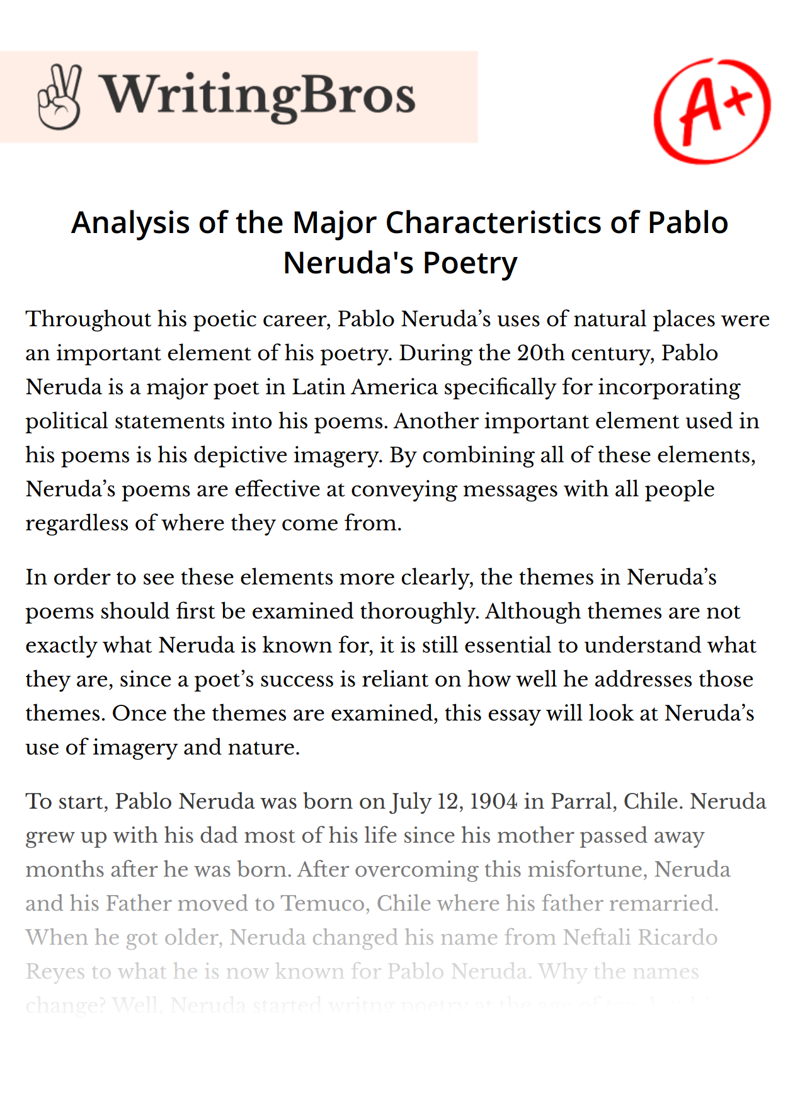Analysis of the Major Characteristics of Pablo Neruda's Poetry

Throughout his poetic career, Pablo Neruda’s uses of natural places were an important element of his poetry. During the 20th century, Pablo Neruda is a major poet in Latin America specifically for incorporating political statements into his poems. Another important element used in his poems is his depictive imagery. By combining all of these elements, Neruda’s poems are effective at conveying messages with all people regardless of where they come from.
In order to see these elements more clearly, the themes in Neruda’s poems should first be examined thoroughly. Although themes are not exactly what Neruda is known for, it is still essential to understand what they are, since a poet’s success is reliant on how well he addresses those themes. Once the themes are examined, this essay will look at Neruda’s use of imagery and nature.
To start, Pablo Neruda was born on July 12, 1904 in Parral, Chile. Neruda grew up with his dad most of his life since his mother passed away months after he was born. After overcoming this misfortune, Neruda and his Father moved to Temuco, Chile where his father remarried. When he got older, Neruda changed his name from Neftali Ricardo Reyes to what he is now known for Pablo Neruda. Why the names change? Well, Neruda started writng poetry at the age of ten, but his father disliked his passion for poetry and tried to discourage him from writing poetry. Therefore, by changing his name, Neruda felt there is no need to hide from being a poet anymore.
Before diving into Neruda’s imagery and use of nature, it is imperative to examine the themes of his work. While Neruda’s poems did contain a significant amount of imagery and nature, these aspects only work in relation to how they present the themes. A poem with vivid imagery but no message has a meaningless purpose. Neruda was a creative writer and his poems reflect upon that. As Neruda’s life was changing, his poems changed along with him. Many of Neruda’s works varies from love, politics, surrealist, and dark topics. Neruda’s love poetry is considered his forte, including Twenty Love Poems and A Song of Despair, his first poetry book.
His first book begins with sensual passion that then detaches into melancholy. The last poem in his book Song of Despair, does the complete opposite from the first poem, where it describes bitterness and hopeless. An example of a dark theme poem would be Pablo Neruda’s a dog has died, where the theme is death, and he expresses death by mentioning his dog’s death. As one can see, Neruda’s poetry contains a variety of themes, which show how diversified this poets experiences have been. (After this I will talk about other poems that contribute to these themes)
Next, Neruda is known for his imagery. While many poets theme consist of love, Neruda’s use of imagery helps him as an individual poet stand out. As one reads his loves poems, one cannot help but continue reading more and more of his poems. This is one of the many reasons why Neruda’s poems are not easily forgotten. (After this, I will mention other poems that correlate to his use of imagery). (Next paragraph I plan to mention his use of nature in his poems).
To sum it up, Pablo Neruda is an important asset of Spanish literature as well as world literature. His poems expressed his individuality, and his diversified collection of poems. He is known for certain literary things, such as imagery and nature, but his have a far deeper meaning than what people usually perceive them as. That is why many of poems have become unforgettable, and continue to be read across the whole world. Without Neruda’s poems, many political statements would not have been made, many dark statements would be kept a secret, and most importantly, many artistic details would not have been unveiled.
Cite this Essay
To export a reference to this article please select a referencing style below

